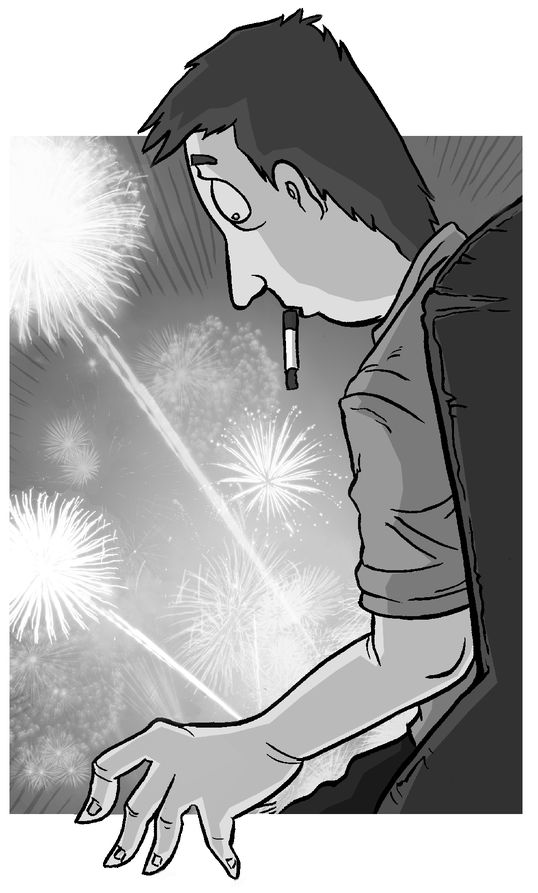The Darwin Awards Countdown to Extinction (5 page)
Read The Darwin Awards Countdown to Extinction Online
Authors: Wendy Northcutt

BOOK: The Darwin Awards Countdown to Extinction
7.82Mb size Format: txt, pdf, ePub
These toxins are much more powerful than snakes seem to need. It’s like they’re rabbit hunting with a bazooka. And the mystery deepens when you consider how costly venom is to produce. One study showed that after being “milked,” rattlesnakes and other pit vipers jack up their metabolic rate by 11 percent for at least three days to refill their glands. So shouldn’t natural selection discourage snakes from making excessively toxic venom?
It should, and it does. Snakes aren’t as loose with their venom as we may think.
Mamba venom did not evolve to kill humans or lab mice. Prey animals are tough, so snakes count on their venom to immobilize their prey, and to do so
fast.
Many venomous snakes tackle feisty, sharp-toothed prey that can outweigh them by 50 percent— formidable foes, especially for animals without arms or legs. A single bite from a wood rat, for example, can snip right through a western diamondback rattlesnake’s spine.
fast.
Many venomous snakes tackle feisty, sharp-toothed prey that can outweigh them by 50 percent— formidable foes, especially for animals without arms or legs. A single bite from a wood rat, for example, can snip right through a western diamondback rattlesnake’s spine.
Venomous Dinosaurs?
A recent fossil analysis provides the most detailed evidence yet that some dinosaurs hunted with venom. Sinornithosaurus, a carnivorous Chinese dinosaur that lived 65-100 million years ago, had fanglike front teeth and a large bony pocket in its upper jaw that likely contained a venom gland. In modern venomous taxa, this type of fang discharges venom along a groove on the outer surface of the tooth.
A recent fossil analysis provides the most detailed evidence yet that some dinosaurs hunted with venom. Sinornithosaurus, a carnivorous Chinese dinosaur that lived 65-100 million years ago, had fanglike front teeth and a large bony pocket in its upper jaw that likely contained a venom gland. In modern venomous taxa, this type of fang discharges venom along a groove on the outer surface of the tooth.
The hypertoxicity of a rattlesnake’s venom helps it prevent this personal tragedy by knocking the rat out in a matter of seconds. The rattlesnake does not care whether his bite
could
dispatch a hundred lab mice, or a thousand. All that matters is that it dispatches one rat with a minimum of muss and fuss before the rat has a chance to dispatch him. Super-toxic venom can thus be thought of as a defensive adaptation: It helps keep snakes safe from prey.
could
dispatch a hundred lab mice, or a thousand. All that matters is that it dispatches one rat with a minimum of muss and fuss before the rat has a chance to dispatch him. Super-toxic venom can thus be thought of as a defensive adaptation: It helps keep snakes safe from prey.
The threat of prey retaliation has been important in snake evolution. For example, many venomous species—including rattlesnakes—instinctively strike and release rodents, then hang back and wait for the reeling animal to keel over. Powerful venom prevents dinner from staggering too far off By contrast smaller less dangerous prey such as lizards are often simply choked down, still struggling.
Extreme toxicity can do more than knock prey out. For example, it can—and often does—help snakes digest their dinners. This is a big deal to serpents, which swallow large animals whole.

Think about that western diamondback again. It strikes a wood rat, tracks the dying animal by homing in on the scent of its own venom, and swallows the prey in one long gulp. Snakes don’t chew their food, so now the snake has an intact rodent clogging its gut.
Such a meal, tempting as it is, would rot inside us before we had a chance to process it. The rattlesnake, however, has an edge: Its venom is packed with proteins that break down tissue. The snake starts digesting the rat from the inside out the moment its inch-long fangs penetrate the rodent’s furry flesh. Tissue-dissolving venom is a key adaptation that allows rattlesnakes and other vipers to consume absurdly large prey.
The bite of a juvenile snake, as most hikers know, can be more dangerous than the bite of an adult. Young snakes are more nervous and have not yet learned to conserve ammunition!
Another reason snake venoms are so toxic is that prey animals are tough. Animals often evolve a degree of resistance to their predators. California ground squirrels, for example, have proteins in their blood that blunt the effects of rattlesnake venom. Sure, a black mamba bite can snuff 9,400 lab mice. But a true assessment of mamba venom toxicity would measure its power to kill natural prey such as African rats. These experiments are seldom done, for it is far easier to work with common, inbred lab mice. But it’s a sure bet that venom from one mamba bite cannot take out 9,400 wild African rats.
Hunter and hunted are engaged in a chemical arms race and have been for millions of years. Lab mice, and the unfortunate Nathan L ayton, never joined this race and are pretty much defenseless. Using them to gauge the strength of mamba venom is like testing a Tomahawk missile against a leather shield. The real-world potency of venom is likely far less than our inflated, artificial estimates.
So give snakes a break. Only about 10 percent of the world’s three thousand snake species are venomous enough to be dangerous to man, and they’re dangerous for good reason: They’re as nasty as natural selection dictates they should be. Yet they’re merciful, too. Remember the poor wood rat that became a meal for our western diamondback? He was unconscious in less than a minute and dead in five. As deaths go, you could do a lot worse.
REFERENCES:
J. E. Biardi, D. C. Chien, and R. G. Coss, “California ground squirrel (
Spermophilus beecheyi
) defenses against rattlesnake venom digestive and hemostatic toxins.”
Journal of Chemical Ecology
31 (2006), 2501-2518.
Spermophilus beecheyi
) defenses against rattlesnake venom digestive and hemostatic toxins.”
Journal of Chemical Ecology
31 (2006), 2501-2518.
H. W. Greene,
Snakes: The Evolution of Mystery in Nature
(Berkeley: University of California Press, 1997).
Snakes: The Evolution of Mystery in Nature
(Berkeley: University of California Press, 1997).
H. Heatwole and N. S. Poran, “Resistances of sympatric and allopatric eels to sea snake venoms,”
Copeia
(1995) 136-147.
Copeia
(1995) 136-147.
M. D. McCue, “Cost of producing venom in three North American pit viper species,”
Copeia
(2006), 818-825.
Copeia
(2006), 818-825.

WEIRD SCIENCE: HUMANS DATING CHIMPS
The idea of humans and chimpanzees swapping genes has been around for decades, but a 2006
Nature
paper
1
provides hard evidence: “The genome analysis revealed big surprises, with major implications for human evolution,” said coauthor and Harvard biologist Eric Lander. The human-chimp speciation occurred slowly, with episodes of hybridization between the emerging species that left a striking impact on the X chromosome. According to Australian anthropologist Colin Groves, species interbred in the wild quite often; even today it could be possible for humans and chimps to have sex and produce offspring, although there would be
ethical problems
.
Nature
paper
1
provides hard evidence: “The genome analysis revealed big surprises, with major implications for human evolution,” said coauthor and Harvard biologist Eric Lander. The human-chimp speciation occurred slowly, with episodes of hybridization between the emerging species that left a striking impact on the X chromosome. According to Australian anthropologist Colin Groves, species interbred in the wild quite often; even today it could be possible for humans and chimps to have sex and produce offspring, although there would be
ethical problems
.
CHAPTER 10
FATHER KNOWS BEST
Father to son: “Glad I stayed around to father
you
. Doesn’t that make you worry? ”
you
. Doesn’t that make you worry? ”
Readers share family stories showing that Father Knows Best—except when he doesn’t. Darwinian dads play with fire—fireworks, dynamite, gas, and ovens—and with ice, hauling refrigerators and hopping icebergs. These fathers survived, they reproduced, and they can only hope that the offspring did not inherit their questionable judgment!
Father (n.): male who begets children
Papa, pops, daddy, dad, padre, papi, abu, baba, sire, ‘rent, progenitor, antecedent, forebearer, paterfamilias, patriarch
Why I’m the Last of Nine Children • My Father, the PhD • Mr. Tinker • Popsicle • Blast from the Past • Volunteer “Fire” Man


Unconfirmed Personal Account
Featuring a father, fireworks, vehicles, and a living Darwin!
How my father eliminated himself from the gene pool
My father tried various ways to remove himself from the gene pool. Most methods were mundane: slow suicide by tobacco, alcohol, bad diet. But one incident stands out, caused by Dad’s habit of driving down the road while lighting firecrackers off his cigarette. Considering Dad’s Darwinian judgment, it was amazing his DNA was so successful.
He enjoyed throwing them out the window as he drove down the street. For convenience he kept the firecrackers in his lap. The fuses were wound together, so he would unwind one, light—throw—
BANG!
Unwind another, light—throw—
BANG!
You get the picture. Uh-huh.
BANG!
Unwind another, light—throw—
BANG!
You get the picture. Uh-huh.
Given time, a person such as this can be relied upon to cause himself harm.
Those who study Darwin know that, given time, a person such as this can be relied upon to cause himself harm. Dear old Dad accidentally added a bounce to his light throw-
bang
sequence: The firecracker
bounced
off the door and back into his lap! A few firecrackers popped, setting of the remaining firecrackers, and there was some prettycreative driving for a while, amid much smoke and cussing.
bang
sequence: The firecracker
bounced
off the door and back into his lap! A few firecrackers popped, setting of the remaining firecrackers, and there was some prettycreative driving for a while, amid much smoke and cussing.

I do not know the extent of the damage to Dad’s reproductive organs—but I
do
know I was the last of nine children!
do
know I was the last of nine children!
Reference: Anonymous daughter
WEIRD SCIENCE: SIX INTRIGUING HUMAN TRAITS
It is not obvious how some aspects of human nature enhance biological success. From the magazine
New Scientist
, some of our quirky foibles that defy explanation:
New Scientist
, some of our quirky foibles that defy explanation:
• Blushing. Charles Darwin himself struggled to explain a response that puts humans at a social disadvantage.
• Laughter.
• Dreams.
• Superstitions.
• Kissing.
• Teenagers. Even the great apes move smoothly from juvenile to adult; why then do humans spend an agonizing decade skulking around in hoodies and ignoring their elders?
Other books
Field of Screams by R.L. Stine
Long Blue Line: Based on a True Story by E. McNew
God's Double Agent by Bob Fu
Made For Us by Samantha Chase
JM02 - Death's Little Helpers aka No Way Home by Peter Spiegelman
Asesinato en el Orient Express by Agatha Christie
Another Kind of Life by Catherine Dunne
Worst Date Ever (Scandals #3) by Kathy Clark
From Sanctum With Love (Masters and Mercenaries Book 10) by Lexi Blake
Correction: A Novel by Thomas Bernhard